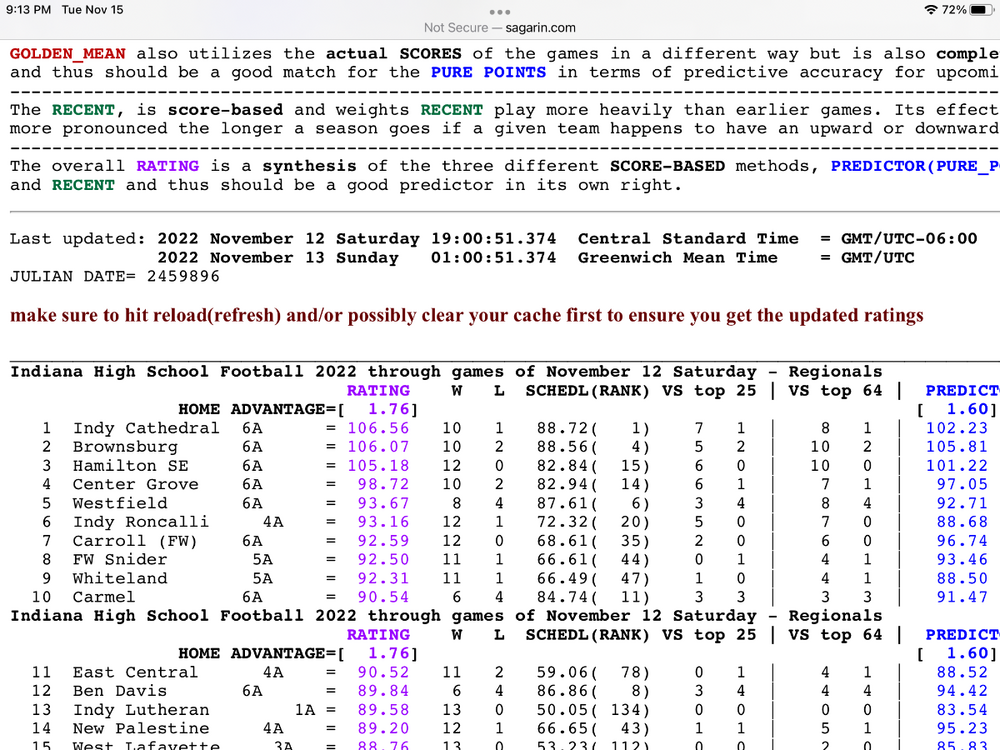-
Posts
6,205 -
Joined
-
Last visited
-
Days Won
258
Content Type
Profiles
Forums
Gallery
Store
Articles
Events
Everything posted by Bobref
-

Cinderella is a myth
Bobref replied to Footballking16's topic in The Indiana High School Football Forum
People believe what they want to believe, evidence to the contrary be damned. -
Rule 4-3-6 “When a team attempts to conserve or consume time illegally, the referee shall order the game or play clock started or stopped.” It’s entirely within the judgment and discretion of the Referee. That’s why wearing that white hat is such an awesome responsibility. There is literally nothing that goes on from the moment you walk on the field until the game is over that you don’t control.
-

Cinderella is a myth
Bobref replied to Footballking16's topic in The Indiana High School Football Forum
Bigfoot is a myth … and yet, there are still sightings. 😆🤣 It was inevitable that this would happen sometime. Bad luck for @Footballking16that it happened this season. But this has been tracked every year I can remember this debate going on, and this is the first time I recall it happening. The bottom line is that it is statistically insignificant. The basic question remains: do you design a system to accommodate the statistical outlier that occurs once every ten years or so? Or, do you design a system that returns benefits every season, to the disadvantage of the one team per decade that bucks the odds? -

Adams Central at North Judson
Bobref replied to RingLeader's topic in The Indiana High School Football Forum
The rules are set out in the IHSAA’s Fall Bulletin. https://www.ihsaa.org/sites/default/files/documents/Fall Bulletin_11.pdf#page17 Here’s what it says: Q. Restrictions Please inform your students and fans that during the game: 1. Banners and posters are not allowed. 2. Battery powered or electronic noise makers, fireworks, recorded music (permissible during- quarter breaks, halftime, and post-game) , sirens or whistles are not allowed. 3. Throwing of articles, including toilet tissue and baby powder, is not allowed. 4. No live animal mascots are permitted at any time. 5. The facility should be as neutral as possible without any enhancements that emphasize a home team. The site manager, who is usually the home team AD, is responsible for enforcing these restrictions. Importantly, the game officials have no responsibility for enforcing these restrictions. -
As I said, Sagarin is an average. Some games, the home field advantage is enormous. Others, not so much. That’s why the best expression of the advantage is a point spread, not a W-L record. And anecdotal evidence is next to useless compared to the law of large numbers. If all you looked at was Ohio State traveling to play IU, you’d conclude there was no home field advantage. If you looked at IU traveling to Columbus, you’d say the advantage was gigantic. There is safety (and greater accuracy) in large numbers of games.
-

Adams Central at North Judson
Bobref replied to RingLeader's topic in The Indiana High School Football Forum
Glad the cannon is gone. First time I worked at NJ I was a back judge, and didn’t know about the cannon. They scored, and that thing went off behind me. It was traumatizing … and that was back when we wore white knickers. Strange things happen there. Once when I was working Referee there, just as I signaled the ball ready for play, a bat landed on the ground between the QB and me. Then the ball was snapped and, I confess, instead of paying attention to my responsibilities, I watched to see if the bat got stepped on. He didn’t. That was a TV game. As soon as I got home I watched the replay, and the bat showed up clearly. -
Almost 2 pts. per game … over the course of 1800 games … that’s a lot of points. Ignore them at your peril. You can bet gamblers don’t think that kind of edge should be “thrown out the window.” And, of course, that includes schools that are 5 minutes apart, as well as the 2 1/2 hr. drive from Valpo to Ft. Wayne. And this is an average. Some games there may be only an infinitesimal advantage. Others, it might be huge. But you said there wasn’t a home field advantage, and there clearly is. Now you’re, as @temptationpredicted, “moving the goalposts” by saying the advantage is only “slight,” or not as great as college or pro. I hate it when he’s right. By the way, I checked. Sagarin’s algorithms produce a home field advantage of 2.00 pts. on his college football page, and 2.18 pts. for the NFL. Not that much different, wouldn’t you say?
-
-
You draw that conclusion simply by comparing W=L records in 45 games in a closed conference? Not nearly a big enough sample size to have statistical significance.. Sagarin’s algorithms churned through about 1500 games this year, and came up with home field advantage of 1,76 pts.
-
No.
-
That’s the question that has to be answered to determine whether long travel is a greater disadvantage than short travel.
-
How does that compare to visiting teams that traveled less than that amount of time at the semistate level?
-
Look at Sagarin
-

Using NCAA fields for high school games?
Bobref replied to gindie's topic in The Indiana High School Football Forum
We play with what we’ve got. -

Adams Central at North Judson
Bobref replied to RingLeader's topic in The Indiana High School Football Forum
I will be at North Judson observing the officiating crew. They are in the running for a state finals assignment. Going to be a cold one! Do they still have that damn cannon? -
No problem. I don’t have actual numbers, but I believe the Indiana formulation is one of the more common such rules.
-
You’re asking the wrong question. Home teams have an advantage. Doesn’t matter whether the visitors travel 15 minutes or 2 hrs. The question is whether the advantage increases with travel time. Got any data on that?
-

5A South SS - Whiteland at Castle
Bobref replied to AW0352's topic in The Indiana High School Football Forum
Threesome? -
After so many years as a Referee, I habitually count the offense every play when I see a game in person. It’s kind of an annoyance.
-
This is a puzzler for me. 3 times in the past two seasons I have seen the following play resulting in a penalty enforcement mistake: QB A1 passes to A6 for a TD. During the play, B4 is flagged for defensive pass interference against A6, who managed to catch the pass despite the interference. In each of the 3 cases, R signaled the penalty as declined, and counted the TD. The amazing thing about it was each of the crews I saw do this was a state finals level crew. One of these instances was in a state final at LOS! Of course, the correct enforcement is to offer Team A the option of enforcing the penalty half the distance on the try, or 15 yds. on the subsequent kickoff. This is not a new rule, and for the life of me I can’t understand why it is mis-enforced so frequently. So, let’s review. This is what the rule says: “ART. 2 . . . If an opponent of the scoring team commits a foul (other than unsportsmanlike conduct or a nonplayer foul) during a down in which a touchdown is scored and there was not a change in possession during the down, A may accept the results of the play and choose enforcement of the PENALTY [sic]: a. On the try, or b. On the subsequent kickoff.” Take note that the penalty does not carry over to the first snap of an OT period since there is no “subsequent kickoff.” In that instance, it can only be enforced on the try. The same options exist on a play where a TD was scored and there was a change of possession during the down, e.g. a pick six, provided the foul by the non-scoring team occurs after the change of possession. If the foul occurs before the change of possession, the scoring team must decline the penalty to keep the score. If there is a foul by the defense on a successful try, or field goal, the options are the same, except the penalty does carry over to the first snap of an OT period. That’s because the wording of the rule as it pertains to trys and field goals is slightly different: “If during a successful [try or field goal], a foul by R occurs, K is given the choice of: a. Accepting the penalty and replaying the down following enforcement; or b. Accepting the result of the play and enforcement of the penalty from the succeeding spot.” (emphasis supplied) Note that after a TD, we carry over to the “subsequent kickoff,” while on a try or field goal, we carry it over to the “succeeding spot.” While there is no kickoff in overtime, there is a succeeding spot. So, coaches, what should you do if you pass for a TD and there’s a defensive penalty, and the Referee simply signals that the penalty is declined and the score is counted? Go immediately to the wing official on your sideline and say the following: “I request a timeout for a coach-official conference to review a possible misapplication or misinterpretation of a rule.” The relevant rule provides: “When a time-out is so granted, the referee will confer with the coach at the sideline in front of his team box in the field of play. If the conference results in the referee altering his ruling, the opposing coach will be notified, the revision made, and the time-out shall be an official’s time-out. If the referee’s ruling prevails, the time-out remains charged to the team requesting the time-out for the conference.” If the team requesting the conference has no timeouts remaining, and the Referee’s ruling stands, it’s a 5 yd. delay of game penalty. I’d enjoy hearing instances where you observed fouls on scoring plays and what the subsequent enforcement was.
-

4A #1 New Palestine at #2 Roncalli
Bobref replied to crimsonace1's topic in The Indiana High School Football Forum
or foot 😂🤣😅 -
You are… but that doesn’t mean you’re wrong. 😅 But 3 measurements? I don’t think I’ve seen 3 all season.
-
At the risk of being told “be careful what you ask for; you might get it,” I’d like to hear how people thought the officiating crew did on the Mishawaka game. My younger brother is the linesman on that crew, and I’m looking for some ammunition to use over the holidays. 😉
-

Does Mishawaka stand a chance?
Bobref replied to Piratefan101's topic in The Indiana High School Football Forum
At the risk of being told “be careful what you ask for; you might get it,” I’d like to hear how people thought the officiating crew did on this game. My younger brother is the linesman on that crew, and I’m looking for some ammunition to use over the holidays. 😉 -

4A #1 New Palestine at #2 Roncalli
Bobref replied to crimsonace1's topic in The Indiana High School Football Forum
What he said.






